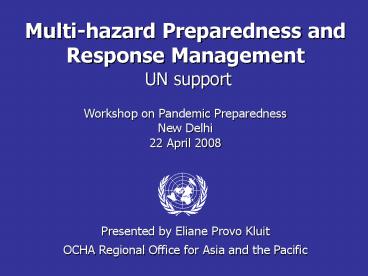Multihazard Preparedness and Response Management UN support PowerPoint PPT Presentation
1 / 15
Title: Multihazard Preparedness and Response Management UN support
1
Multi-hazard Preparedness and Response
Management UN support
Workshop on Pandemic Preparedness New Delhi22
April 2008Presented by Eliane Provo Kluit
OCHA Regional Office for Asia and the Pacific
2
Four Pillars of Humanitarian Reform
PARTNERSHIP Strong partnerships between UN and
non-UN actors
HUMANITARIAN COORDINATORS Effective leadership
and coordination in humanitarian emergencies
CLUSTER APPROACH Adequate capacity and
predictable leadership in all sectors
HUMANITARIAN FINANCING Adequate, timely and
flexible financing
3
Building Stronger Partnerships
- Humanitarian actors work as equal partners,
respecting each others roles and mandates - Partnerships may take different forms, from joint
programming to much looser associations - IASC Country Teams are a requirement in all
countries with HCs
4
- Whose reform?
- Inter-Agency Standing Committee (IASC)
- Composed of NGO consortia, Red Cross and Red
Crescent Movement, IOM, World bank and UN
agencies
5
IASC Tools
- In-country Self-Assessment
- Inter-Agency Contingency Planning
- Joint Logistics Center
- Humanitarian Information Center
- UNDAC
- Guidelines for use of Cluster Approach
- Specific Response Plans
6
New Global Cluster Leads
- Technical areas
- Nutrition UNICEF
- Water/Sanitation UNICEF
- Health WHO
- Emergency Shelter Conflict IDPs UNHCR
- Disasters IFRC Convenor
- Cross-cutting areas
- Camp Coord/Mgmt Conflict IDPs UNHCR
- Disasters IOM
- Protection Conflict IDPs UNHCR
- Disasters civilians
- in conflict (non-IDPs) HCR/OHCHR/UNICEF
- Early Recovery UNDP
- Common service areas
- Logistics WFP
- Telecommunications
OCHA/UNICEF/WFP
7
Predictable Funding
- Creation of a Central Emergency Response Fund
- Improve response to new and rapidly deteriorating
crises, and needs in chronically under-funded
emergencies. - Target of 500 million to be achieved over three
years (450 million grant, 50 million revolving
loan) - Fully funded CERF represents 4 of global
humanitarian funding (USD 500 million out of USD
13 billion)
8
IASC Contingency Planning
- UN RC/HCs responsible for the development and
maintenance of contingency plans for the IASC. - Management tool to ensure that adequate
arrangements are made in anticipation of a
crisis. - Inter-agency plan act as an umbrella
consolidates agency and sector plans. - Preparedness achieved primarily through
participation in the contingency planning process
itself.
9
What is Inter-Agency Planning
- Common analysis of potential emergencies and
their impact - Common prioritization of potential emergencies
- Developing plans to deal with prioritised
potential emergencies - Division of labour among actors
- Ensuring necessary preparedness measures and
follow-up actions are taken.
10
Lessons from CP in Asia and the Pacific
- Key elements of the Humanitarian Reform have been
incorporated. Regional IASC Network involved in
support for country-level planning. - Pandemic preparedness, data readiness and crisis
communications now common in inter-agency
contingency planning. - Non-health aspects of pandemic planning will
require inter-agency response, not unlike
response to natural disaster and complex
emergency scenarios. - Need to ensure continuous process. The process is
important not the production of a document! - IASC Inter-Agency Contingency Planning Guidelines.
11
Remaining Challenges
- Challenges
- Many CP exercises do not lead to sustainable
contingency planning processes. One-off events
with static planning documents still common. - There is still an over-reliance on external
facilitation of CP. In-country ownership remains
a challenge. - Successes often undone by staff turn-over. Lack
of sustainable planning processes then becomes
apparent.
12
Remaining Challenges
- Challenges (cont.)
- Lack of overall monitoring of preparedness status
of IASC Country Teams. - IASC tool kit is still rather weak. Best
practices not exchanged. Examples of good
planning documents/processes rarely shared
between countries/regions. - Global AHI preparedness efforts are a good
example of how monitoring and overall guidance
can produce results. Resources, accountability,
framework, deadlines, etc. Greater exchange of
lessons and integration would be helpful.
13
Possible Comparative Strengths
- AHI Preparedness
- Directive to UN Country Teams
- Accountability
- Time-lines
- Tool kit for planning
- Testing of preparedness
- Funding
- IASC Contingency planning
- Long-term processes
- Focus on worst-case scenario
- Coordination among all IASC members under RC/HC
14
Opportunities for Integration
- Pandemic scenarios are considered as part of IASC
Contingency Planning, particularly non-health
humanitarian aspects. - Multi-hazard planning promoted vis-à-vis IASC
Country Teams. - Considering complex/overlapping scenarios (e.g.
AHI and natural disasters, monitoring in
emergency situations, etc.)
15
- Thank you

